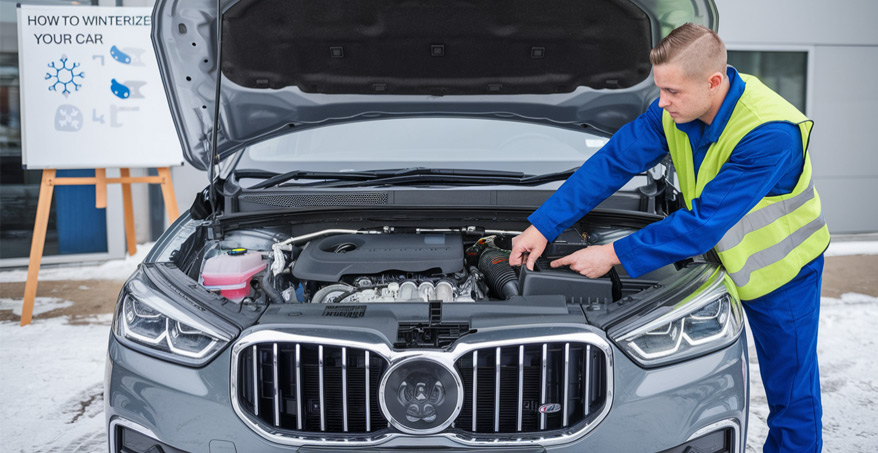Winterizing your car ensures safety, reliability, and optimal performance during cold weather and icy road conditions.
As temperatures drop and roads become more treacherous, preparing your car for winter is essential for safety and performance. Winterizing your vehicle ensures it can withstand icy roads, freezing temperatures, and heavy snow, keeping you safe and avoiding unexpected breakdowns.
Below is a step-by-step guide packed with valuable tips to help you prepare your car for winter weather conditions.
1. Check and Replace Your Tires
Winter roads demand excellent traction. If you live in areas prone to heavy snow or icy roads, consider installing winter tires. These are specially designed to provide better grip in low temperatures and on slippery surfaces.
- Inspect your tire tread depth: Ensure at least 6/32 of an inch for optimal performance.
- Check tire pressure regularly: Cold air reduces tire pressure, which can affect handling and fuel efficiency.
For drivers in milder winter climates, all-season tires might suffice, but always prioritize those with the “M+S” (mud and snow) symbol for added traction.
2. Top Off and Replace Fluids
Fluids play a crucial role in maintaining your car’s performance during the winter months. Here are the key fluids to check:
- Antifreeze (coolant): Ensure your car’s coolant-to-water ratio is correct, typically 50:50. This prevents your engine from freezing.
- Windshield washer fluid: Use a winter-grade formula that won’t freeze in cold weather.
- Oil: If your area experiences extreme cold, switch to a thinner, winter-grade oil recommended by your vehicle’s manufacturer.
3. Inspect the Battery
Cold weather puts extra strain on car batteries, often reducing their efficiency. A weak battery is one of the main culprits behind winter breakdowns.
- Test your battery voltage: A fully charged battery should read about 12.6 volts.
- Clean corrosion: Ensure the terminals and cables are clean and secure.
- Replace if needed: If your battery is over three years old, consider replacing it to avoid surprises.
4. Upgrade Your Wiper Blades
Visibility is critical during winter storms. Winter wiper blades are designed to handle snow and ice buildup better than standard blades. Don’t forget to:
- Replace old wiper blades if they streak or squeak.
- De-ice your windshield and wipers before driving to prevent damage.
5. Prepare a Winter Emergency Kit
Even the best preparations can’t prevent all emergencies. Having a winter car survival kit can be a lifesaver in case of breakdowns or accidents. Include:
- A flashlight and extra batteries
- Warm blankets and gloves
- Ice scraper and snow brush
- Jumper cables
- Sand or kitty litter for traction
- Non-perishable snacks and water
6. Inspect Brakes and Suspension
Icy and snowy roads demand that your brakes perform flawlessly.
- Have your brakes inspected for wear and tear.
- Check your suspension system for any issues, as it affects how your car handles on slippery surfaces.
7. Check Your Heating and Defrosting Systems
A functioning heating system keeps you warm, while a reliable defroster ensures visibility by clearing fog or frost from your windows. Test both systems before winter fully sets in to avoid discomfort or dangerous driving conditions.
8. Protect Your Car’s Exterior
Winter roads often mean exposure to road salt, which can corrode your car’s paint and undercarriage.
- Apply a coat of wax before winter to create a protective barrier.
- Wash your car frequently during winter to remove salt buildup, especially underneath.
9. Keep Your Gas Tank Full
Keeping your gas tank at least half full during the winter prevents condensation from forming inside the tank. It also ensures you won’t run out of fuel in case of long delays or emergencies.
10. Check Lights and Electronics
Shorter daylight hours and stormy weather make visibility more critical than ever.
- Test all exterior lights, including headlights, fog lights, and brake lights.
- Replace dim or burnt-out bulbs immediately.
Final Thoughts
Winterizing your car is more than just a safety measure—it’s a smart way to protect your investment and ensure peace of mind during the colder months. By taking these proactive steps, you’ll be prepared for whatever winter throws your way, from freezing temperatures to unexpected snowstorms.
Embrace these tips to stay ahead of the season and make winter driving safer and more reliable.


